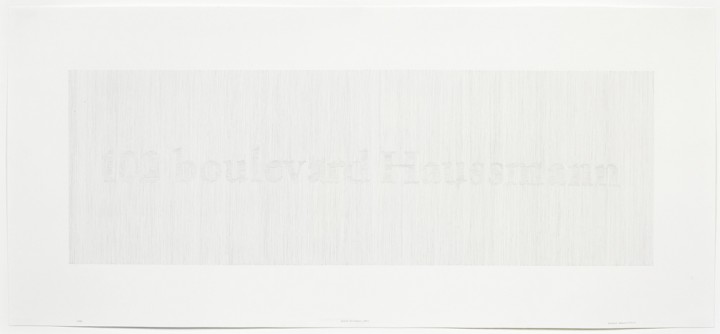
Audio Transcript
Emerging from the scores of vertical graphite striations lining the surface of this drawing, the words 102 boulevard Haussmann denote more than a physical location within the city of Paris. The phrase—an address, a place-name—describes a location in which events and interactions occurred, in which memories were formed, in which experiences were had. Once the residence of the French novelist Marcel Proust (1871-1922), 102 boulevard Haussmann is now a place rife with history, resonating with the significant moments, occasions, and encounters of those who have lived there. The place-name itself has become charged with meaning; the phrase is an evocation of the past, a key to the memories that were produced within the building’s walls.
Susanna Harwood Rubin’s fascination with memory and the ways in which it functions is drawn from her study of Proust and his multi-volume novel Remembrance of Things Past (À la recherché du temps perdu), first published between 1913 and 1927. Proust’s preoccupation with the idea of memory was rooted in his understanding of le temps perdu, or lost time. To Proust, the notion of time was more than a quantitative measure of progress. Rather, it was a qualitative experience that, as it passed, was lost, leaving behind only the sensations felt—the sounds heard, the sights seen, the tastes and the smells. Any fragment of one’s past—be it an object, a location, or a scent—has the power to recall these sensations from deep within one’s subconscious mind. The place-name is an especially powerful prompt for memories. Merely seeing or hearing the words that describe a significant place can summon reminders of events that happened there.
In homage to Proust, Harwood Rubin created evocations of the places he inhabited in Paris. Tracing the author’s movements through the city, Harwood Rubin documented five of his residences, including 102 boulevard Haussmann. As she wrote of her project, “These patterns and designs…became symbols and emblems of their locations, serving as signs for those particular places, and whatever event or conversation had happened there. Each detail was both a container and a trigger for memory.”1 102 boulevard Haussmann is a place-name laden with substance and meaning. For the viewer, Harwood Rubin’s drawing encourages meditative reflection and the recollection of site-specific memories.
1. Susanna Harwood Rubin, “Proust Walk,” unpublished artist’s statement, 2000.
Susanna Harwood Rubin Biography
Dayle Wood Biography